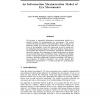Free Online Productivity Tools
i2Speak
i2Symbol
i2OCR
iTex2Img
iWeb2Print
iWeb2Shot
i2Type
iPdf2Split
iPdf2Merge
i2Bopomofo
i2Arabic
i2Style
i2Image
i2PDF
iLatex2Rtf
Sci2ools
NIPS
2004
2004
An Information Maximization Model of Eye Movements
We propose a sequential information maximization model as a general strategy for programming eye movements. The model reconstructs high-resolution visual information from a sequence of fixations, taking into account the fall-off in resolution from the fovea to the periphery. From this framework we get a simple rule for predicting fixation sequences: after each fixation, fixate next at the location that minimizes uncertainty (maximizes information) about the stimulus. By comparing our model performance to human eye movement data and to predictions from a saliency and random model, we demonstrate that our model is best at predicting fixation locations. Modeling additional biological constraints will improve the prediction of fixation sequences. Our results suggest that information maximization is a useful principle for programming eye movements.
Related Content
| Added | 31 Oct 2010 |
| Updated | 31 Oct 2010 |
| Type | Conference |
| Year | 2004 |
| Where | NIPS |
| Authors | Laura Walker Renninger, James M. Coughlan, Preeti Verghese, Jitendra Malik |
Comments (0)

